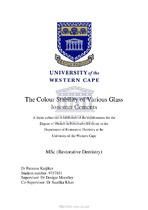| dc.description.abstract | Introduction: Together with bonding to both enamel and dentine, an ideal restorative material would display physical properties similar to that of natural tooth tissue and would not be prone to degradation as a result of the oral environment. This includes changes in colour. Glass ionomer technology has undergone many changes to its original chemistry since it was developed in the early 1970’s. In 1988 resin-modified glass ionomers were introduced and in 2008, nano-ionomers were introduced. As a result of the progression in material sciences and the use of more sophisticated techniques and methods in restorative dentistry, it is possible to accomplish much improved aesthetics and functional durability of a restoration, both anteriorly and posteriorly. However, for as long as aesthetic restorations have been available, and in spite of advances in material structure and performance, one of the greatest challenges facing clinicians still remains that aesthetic restorations have to be replaced relatively frequently as staining and discolouration is a common problem. Aim of the study: The aim of this study was to determine the stainability of four resin-modified glass ionomers and one glass ionomer cement when exposed to a staining broth. Objectives: To record any change in colour before and after exposing the sample with the staining broth using a spectrophotometer, to compare the stainability, to examine the depth of staining using a light microscope and to observe the particle size of the powder and the surface texture using Scanning Electron Microscopy of the four resin- modified glass ionomer cements and one glass ionomer cement. Materials and Methods: Four resin-modified glass ionomers (one nano-ionomer) and one glass ionomer (zinc-reinforced ionomer) were selected. All were shade A2, except for Vitremer™ which was not available in A2. 15 discs of each material were prepared. The discs were 15 mm in diameter and 2 mm in thickness. All the materials were handled and cured according to the manufacturers’ instructions. After curing, only one side of each disc was polished using Sof-Lex™ discs (3M ESPE, USA). The unpolished side of each disc was designated as a matrix finish. The specimens were all immersed in distilled water at 37 °C for one week. They were then immersed in a staining broth for a period of one week and readings were taken after a period of 2 hours, 4 hours, 8 hours, 24 hours and one week. Colour was read on each side of each disc at the indicated intervals with a spectrophotometer. The colour difference was calculated using the CIELAB colour co-ordinates. Sample discs were then sectioned to determine the depth of staining. An additional sample disc of each material was made for observation with the SEM and was therefore not stained. Also, an unmixed sample of each material was prepared for examination with the SEM. Results: In general, for all materials there was an increase in staining when assessed with the colour difference between the baseline colour and the 7 day reading. Ketac™ N100, showed the highest total colour change of 43.84 for the unpolished surface followed by Riva™ which showed the total colour change of 28.55 for the unpolished surface. This was similar to Fuji II LC® which had a total colour change of 28.16 for the unpolished surface. For Vitremer™, the total colour change increased to 18.07 for the unpolished surface. For the unpolished surfaces, ChemFil™ Rock showed the least colour difference from baseline to 7 days (ΔE*ab = 10.45), followed by Vitremer™ (ΔE*ab = 18.07). Both Fuji II LC® and Riva™ Light Cure showed similar colour change from baseline to 7 days for unpolished surfaces (ΔE*ab of 28.16 and 28.55 respectively). Ketac™ N100 showed the highest staining after 7 days in the staining broth with a colour difference of 43.84. For the polished surfaces, the colour change for Fuji II LC® was 25.72 which was similar to Riva™ Light Cure which was 22.44 and Ketac™ N100 which showed a colour change of 22.79 on the polished surface. ChemFil™ Rock showed the least colour change of 17.69 for the polished surface followed by Vitremer™ which showed a colour change of 23.63 for the polished surface. Thus, for both the unpolished and polished surfaces there was a similar staining pattern. Conclusion: In this study it was demonstrated that all products evaluated in this study showed some degree of staining when exposed to a staining broth when evaluated using the ΔE*ab CIELAB colour evaluation. Ketac™ N100 showed the highest colour change compared to the other materials, but the reason for this was not explored. Both Vitremer™ and ChemFil™ Rock showed similar patterns of staining. | en_US |

